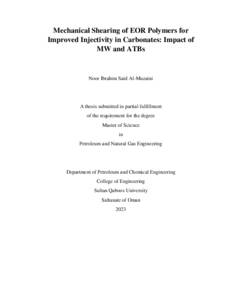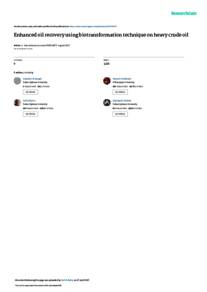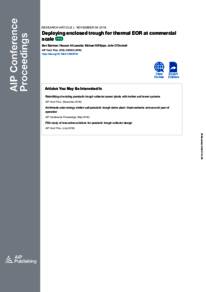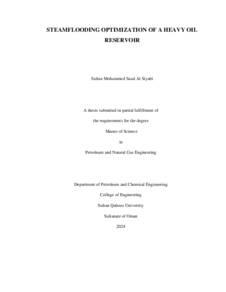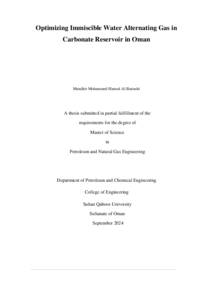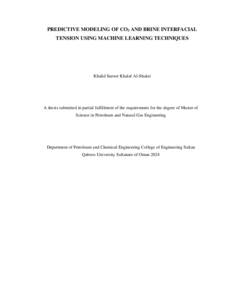Document
Mechanical shearing of EOR polymers for improved injectivity in carbonates : impact of MW and ATBs.
Other titles
القص الميكانيكي لبوليمرات الاستخلاص المعزز للنفط من اجل تحسين الحقن في الخزانات الكربونية : تأثير الوزن الجزيئي و ATBS
Publisher
Sultan Qaboos University.
Gregorian
2023
Language
English
English abstract
Polymer flooding is a proven enhanced oil recovery (EOR) technique that uses polymers
to maintain a favorable mobility ratio between the displacing fluid (i.e., polymer solution)
and the displaced fluid (i.e., oil) for the volumetric sweep efficiency to be improved and
thus, oil recovery to be enhanced. Conversely, its applications were mainly geared towards
sandstones, where the environmental conditions encountered by the polymers are
insufficient to affect their initial properties severely. The decline in oil production besides
the complexity of discovering new reservoirs diverted the attention towards extracting oil
from more challenging reservoirs like carbonates. Carbonate reservoirs hold the largest
portion of the world's oil reserves but they are known for their harsh conditions, including
but not limited to high salinity, hardness, temperature and low permeability, which hamper
the successful application of polymer flooding.
This study aimed at evaluating eight different polymers for application in carbonate
reservoirs subjected to different shear rates with the objective of identifying feasible and
mechanically stable polymers under harsh conditions of salinity (196,000 ppm) and
temperature (75℃). The evaluation procedure included bulk rheology, shear stability,
filterability, oscillatory and injectivity tests.
The bulk rheological tests proved the robustness of sulfonated polymers in resisting the
harsh conditions of this study but suggested that under such conditions, there existed a
maximum allowable ATBs content beyond which the ATBs based polymers might lose
their high viscosifying power. Furthermore, the oscillatory tests revealed the side effect of
incorporating the resistant monomer, ATBs, into polymer's formulation on the viscoelastic
properties. Based on the performed oscillatory tests, ATBs seems to weaken the elastic
properties of the polymers. The shear stability tests showed that the ATBs based polymers
are more shear resistant than the zero ATBs polymers with the MW being the most
dominant factor affecting the shear stability of the ATBs based polymers. As a result, the
highly sulfonated polymer (SAV10) and the moderately sulfonated polymer (AN125),
which have the lowest MW(s) among all the tested polymers, were the most shear resistant
polymers. Furthermore, the filtration tests showed that these two polymers exhibited the
best filterability. Consequently, these two polymers were selected for the subsequent
injectivity tests. Six injectivity tests were carried out, using SAV10 and AN125 in their
sheared and un-sheared states and SAV10MPM in its un-sheared state, in order to assess
the potentiality of polymer flooding in very tight carbonates. Successful polymer
propagation was observed for the highly sulfonated polymer, SAV10, in both its sheared
and un-sheared states. Besides, its results showed that pre-shearing the polymer results in
a significant improvement in its injectivity. Moreover, the highly sulfonated polymer
SAV10MPM, which has a lower MW compared with SAV10 and AN125, showed
successful accessibility. In spite of that, the injectivity performance of the sheared solution
of SAV10 remained much better than SAV10MPM. Furthermore, the moderately
sulfonated polymer, AN125, exhibited unsatisfactory injectivity performance
characterized by higher resistance factors than the sheared solution of SAV10, regardless
of its lower MW compared with SAV10, even at its sheared state. This signals the
importance of the high sulfonation under such harsh conditions. All in all, the results of
this study suggest that the best option for a successful polymer flooding project in tight
carbonates under harsh conditions is to go for a highly sulfonated polymer with a moderate
MW, after which the polymer has to be pretreated through shearing and filtering to ensure
successful polymer propagation and better sweep efficiency. This is because a lower
dosage would be required, besides the significant improvements in the polymer's
injectivity.
Member of
Resource URL
Arabic abstract
غمر البوليمر هو أحد تقنيات الاستخلاص المعزز للنفط )EOR )التي أثبتت جدواها والتي يتم فيها استخدام البوليمرات للحفاظ على نسبة تنقل مناسبة بين سائل الإزاحة )أي محلول البوليمر( والسائل المزاح )أي النفط( لتحسين كفاءة الكنس الحجمي وبالتالي تعزيز استخراج النفط. تطبيقات هذه التقنية كانت موجهة بشكل أساسي نحو الخزانات الرملية، حيث تكون ظروف مكامن النفط التي تواجهها البوليمرات غير كافية للتأثير على خصائصها الأولية بشكل كبير. أدى الانخفاض في إنتاج النفط إلى جانب صعوبة اكتشاف مكامن جديدة إلى تحويل الانتباه إلى استخراج النفط من الخزانات الأكثر صعوبة مثل الخزانات الكربونية. تحتوي الخزانات الكربونية على الجزء الأكبر من احتياطيات النفط في العالم ولكنها معروفة بظروفها القاسية، بما في ذلك على سبيل المثال ال الحصر: ارتفاع الملوحة ، صالبة مياه المكمن، درجة الحرارة و قلة النفاذية، مما يعيق التطبيق الناجح لغمر البوليمر. هدفت هذه الدراسة إلى تقييم ثمانية بوليمرات مختلفة للتطبيق في الخزانات الكربونية وذلك بتعريضها لمعدالت قص في ظل ظروف ملوحة عالية )196000 جزء في المليون( مختلفة بهدف اختيار بوليمر قابل للتطبيق ومستقر ميكانيكياً ودرجة حرارة )75 درجة مئوية(. تضمنت إجراءات التقييم اختبارات الريولوجيا السائبة، استقرار القص، قابلية الترشيح ، اختبارات التذبذب والحقن. أثبتت اختبارات الانسيابية السائبة متانة البوليمرات المسلفنة في مقاومة الظروف القاسية لهذه الدراسة مع وجود حد أقصى مسموح به لمحتوى ال ATBs والذي في حال تجاوزه قد تفقد بوليمرات ATBs قدرتها العالية على زيادة اللزوجة. عالوة على ذلك، كشفت االختبارات التذبذبية عن اآلثار الجانبية لدمج المونومر المقاوم، ATBs، في تركيبة البوليمر على خصائص اللزوجة المرنة. بنا ًء على الاختبارات التذبذبية التي تم إجراؤها، يبدو أن مونومر ال ATBs يضعف الخصائص المرنة للبوليمرات. أظهرت اختبارات ثبات القص أن البوليمرات القائمة على ATBs أكثر مقاومة للقص من البوليمرات الخالية من ال ATBs، مع كون الوزن الجزيئي العامل الأكثر تأثيرا على استقرار القص للبوليمرات القائمة على ATBs. نتيجة لذلك، كان البوليمر عالي محتوى ال ATBs( 10SAV )والبوليمر معتدل محتوى ال ATBs( 125AN )، اللذان يمتلكان أقل وزن جزيئي بين جميع البوليمرات المختبرة، أكثر البوليمرات مقاومة للقص. عالوة على ذلك، أظهرت اختبارات الترشيح أن هذين البوليمرين أظهرا أفضل قابلية للترشيح. وبالتالي، تم اختيار هذين البوليمرين لاختبارات الحقن اللاحقة. تم إجراء ستة اختبارات للحقن، باستخدام 10SAV و 125AN في حالتيها العادية و المعالجة )القص المسبق( و MPM10SAV في حالته العادية، من أجل تقييم إمكانية غمر البوليمر في صخور كربونية قليلة النفاذية. لوحظ حقن جيد للبوليمر عالي ATBs المحتوى )10SAV)، في كلتا حالتيه، العادية و المعالجة. إلى جانب ذلك، أظهرت النتائج أن القص المسبق للبوليمر يؤدي إلى تحسن كبير في حقنه. علاوة على ذلك، أظهر البوليمر عالي ATBs المحتوى )MPM10SAV )، والذي يحتوي على وزن جزيئي أقل مقارنة بـ 10SAV و 125AN ، إمكانية حقن جيد. ظل أداء الحقن لمحلول 10SAV المعالج أفضل بكثير من MPM10SAV. عالوة على ذلك، أظهر البوليمر المسلفن بشكل معتدل )125AN)، أداء حقن غير مرضي يتميز بعوامل مقاومة أعلى من المحلول المعالج لـ 10SAV ، على الرغم من كون وزنه الجزيئي اقل مقارنة بـ 10SAV، حتى في حالته المعالجة. هذا يشير إلى أهمية ارتفاع نسبة السلفنة في البوليمر في ظل هذه الظروف القاسية. بشكل عام، تشير نتائج هذه الدراسة إلى أن الخيار الأفضل لمشروع غمر بوليمر ناجح في الخزانات الكربونية و في ظل ظروف قاسية هو استخدام بوليمر عالي السلفونات أو من خلال القص و الترشيح لضمان انتشار البوليمر بنجاح معتدل الوزن الجزيئي، وبعد ذلك يجب معالجة البوليمر مسبقً وكفاءة مسح أفضل. وذلك ألنه قد يودي الى استخدام كمية أقل من البوليمر، باإلضافة إلى التحسينات الهامة في حقن البوليمر.
Category
Theses and Dissertations

